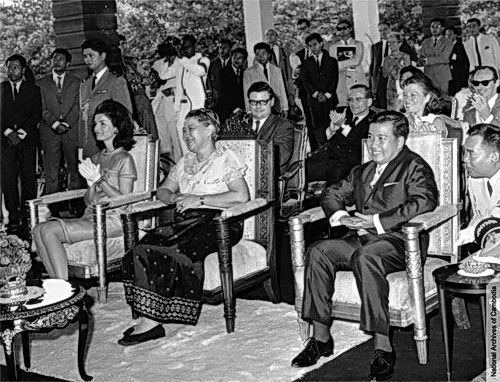Coronation 5 March 1955 Children Norodom Sihanouk Name Sisowath Kossamak | ||
Tenure 3 March 1955 – 3 April 1960 Parents Sisowath Monivong, Norodom Kanviman Norleak Tevi Grandchildren Norodom Sihamoni, Norodom Buppha Devi Similar People | ||
Reverencia del protocolo asi tico a la reina sisowath kossamak nearireath de camboya
Preah Mahaksatriyani Sisowath Monivong Kossamak Nearirath Serey Vathana (Khmer: ព្រះមហាក្សត្រិយានី ស៊ីសុវត្ថិមុនីវង្ស កុសុមៈនារីរ័ត្នសេរីវឌ្ឍនា; 9 April 1904 – 27 April 1975) was the Queen consort of Cambodia from 1955 to 1960 by marriage to King Norodom Suramarit. Sisowath Kossamak was born Princess of Cambodia as the daughter of King Sisowath Monivong of Cambodia. After her husband's death, she became the symbol and representative of the monarchy while her son assumed his duties as Head of State.
Contents
- Reverencia del protocolo asi tico a la reina sisowath kossamak nearireath de camboya
- Klairung amratisha queen sisowath kossamak 1 3
- Biography
- Foreign honour
- References

Klairung amratisha queen sisowath kossamak 1 3
Biography

Sisowath Kosamak married her father's cousin Norodom Suramarit in 1920. Upon the death of her father Monivong in 1941, Sihanouk, her son and Monivong's grandson, was selected as the new king. In the 1940s, she famously choreographed the apsara dance by training her first grand daughter, Princess Norodom Bopha Devi, to become the first Apsara dancer.

In 1955, Sihanouk abdicated in favor of his father. Queen Kossamak enjoyed great respect and popularity: despite neither a monarch nor politically influential, she was said to exert great moral authority over the khmers, was described as generous to the poor and devoting herself to the welfare of the nation. As queen, she received foreign guests and hosted state functions, were the royal ballet often performed. Like her daughter-in-law, she was accused of promoting proteges to civil offices. She was not on good terms with her daughter-in-law, princess Monique, which led to advisories blaming Monique for the sometime strained relationship between Kossamak and Sihanouk, and for Sihanouk alleged initial hesitance to abdicate as it would make his mother queen.
Following Suramarit's death in 1960, Norodom Sihanouk again became head of state (although he did not formally regain the title of king until after other periods in 1993). There were suggestions of changing the constitution to allow for Kossamak to succeed as queen regnant and monarch in her own name, but the royal council was unwilling to allow it: her son Sihanouk stated that only God knew his reasons to why he did no wish his mother to succeed to the throne.
Queen Kossamak continued in her representational role during the reign of her son as premier during the 1960s. She also upheld her great popularity. In 1965, a serious conflict arouse, when an American paper published slander accusing her of greed and of managing brothels. This incident led to the attack of the American embassy in Phnom Penh and Sihanouk cutting diplomatic relations with the USA.
After the coup of 1970, Kossamak was forced to leave the royal palace by the new government and held in house arrest in a villa in the suburb. She was allowed to join her son in Beijing in China for health reasons in 1973. She died in China two years later.
